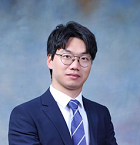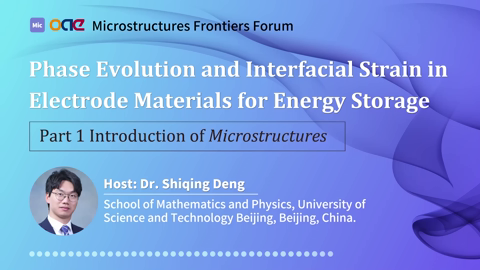Contents
Host

Dr. Shiqing Deng
School of Mathematics and Physics, University of Science and Technology Beijing, Beijing, China.
Junior Executive Editor of Microstructures
Speaker
Professor Dong Su
Beijing National Laboratory for Condensed Matter Physics, Institute of Physics, Chinese Academy of Sciences, Beijing, China.
Dr. Dong Su is a Professor at Institute of Physics (IOP), Chinese Academy of Sciences (CAS). Before joining IOP, he was the group leader of electron microscopy in Center for Functional Nanomaterials at Brookhaven National Laboratory until August 2019. He has been an adjunct professor in the Department of Materials Science and Engineering at Stony Brook University from 2011-2021. He got his B.S. in 1998 from Nanjing University. He got his Ph.D in condensed matter physics in 2003, from Nanjing University and Institute of Physics, CAS. After doing postdoc in EPFL, Switzerland, University of Illinois at Urbana-Champaign, and Arizona State University, he joined Brookhaven National Laboratory in 2008 as an assistant scientist. He has been through the rank and was promoted to the scientist with continuing appointment in 2015. Dr. Dong Su has published more than 400 papers in peer-reviewed journals with > 37000 citations and has an H factor of 94 (google). He has been a highly cited researcher (clarivate) from 2019-2021. He has given more than 50 invited talks in international conferences and university seminars.
Programme
Programme
Advanced (scanning) transmission electron microscopy ((S)TEM) techniques have been intensively applied to study the materials for energy storage. With/Combining different TEM techniques, including in-situ TEM and diffraction, HAADF-STEM, and STEM-electron energy-loss spectroscopy, researchers are able to probe local structural and chemical information of electrode materials. The first part of this talk will focus on using in-situ and analytical TEM to characterize the oxide electrode materials of lithium ion batteries [1-4]. The dynamical process of the redox reaction revealed by in-situ TEM may help us to understand how reaction pathways and defects affect the batteries’ kinetic properties. The second part of this talk highlights the importance of advanced TEM for developing electrocatalysts, in combination of electrochemical characterization and first principles calculations [5-8]. We will discuss the recent progresses in the Pt-based nanocatalyst for proton exchange membrane fuel cells, especially on how the strain affecting the surface electronic structure and how to tune the synthesis process to obtain the high efficient catalysts.
References:
[1] K. He, et al., Nature Communications, (2016) 7:11441.
[2] S. Hwang, et al., Angewandte Chemie International Edition, (2017) 56, 7813
[3] J. Li, et al., Nature Communications, (2019) 10:2224.
[4] S. Li, et al., Angewandte Chemie International Edition, (2020) 132,22276
[5] L. Bu, et al., Science, (2016) 354, 1410
[6] X. Wang , et al. Nano Letters, (2018) 18, 4163
[7] J. Liang, et al. Joule, (2019) 3, 956
[8] X. Li, et al. Advanced Materials, (2021) 33, 2106371
References:
[1] K. He, et al., Nature Communications, (2016) 7:11441.
[2] S. Hwang, et al., Angewandte Chemie International Edition, (2017) 56, 7813
[3] J. Li, et al., Nature Communications, (2019) 10:2224.
[4] S. Li, et al., Angewandte Chemie International Edition, (2020) 132,22276
[5] L. Bu, et al., Science, (2016) 354, 1410
[6] X. Wang , et al. Nano Letters, (2018) 18, 4163
[7] J. Liang, et al. Joule, (2019) 3, 956
[8] X. Li, et al. Advanced Materials, (2021) 33, 2106371
Moments
Presentation

Phase Evolution and Interfacial Strain in Electrode Materials for Energy Storage:Part 1 Introduction of Microstructures
NaN

Phase Evolution and Interfacial Strain in Electrode Materials for Energy Storage:Part 2 Report
NaN

Phase Evolution and Interfacial Strain in Electrode Materials for Energy Storage:Part 3 Discussion
NaN






